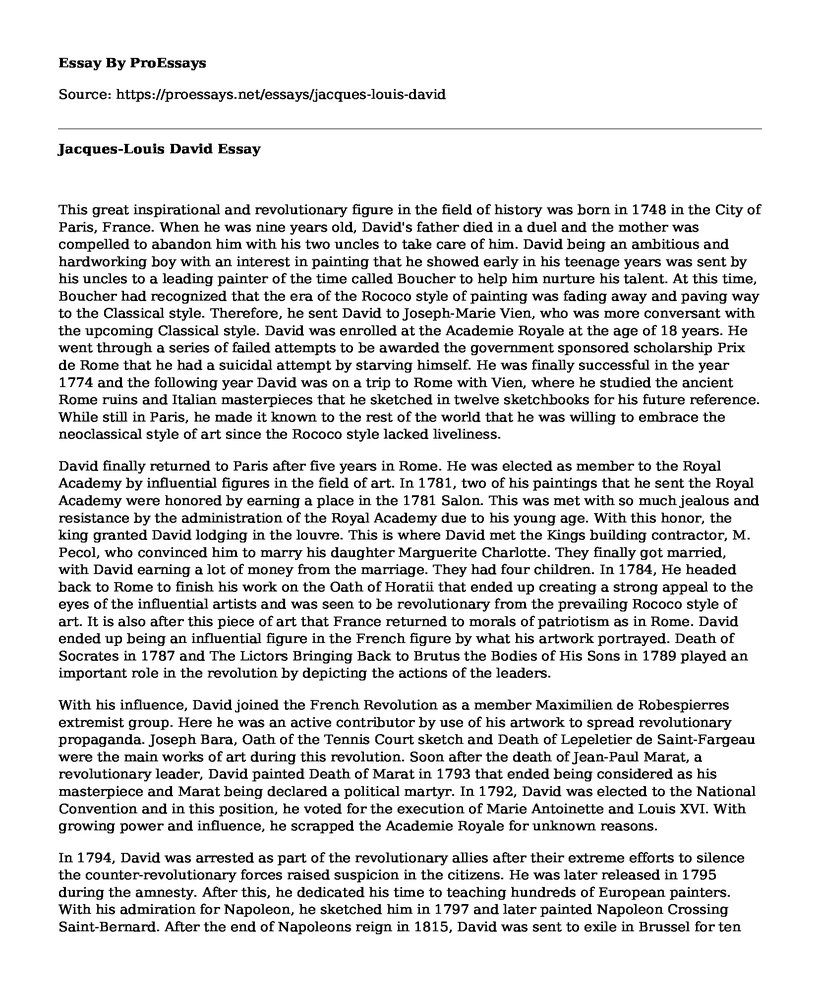This great inspirational and revolutionary figure in the field of history was born in 1748 in the City of Paris, France. When he was nine years old, David's father died in a duel and the mother was compelled to abandon him with his two uncles to take care of him. David being an ambitious and hardworking boy with an interest in painting that he showed early in his teenage years was sent by his uncles to a leading painter of the time called Boucher to help him nurture his talent. At this time, Boucher had recognized that the era of the Rococo style of painting was fading away and paving way to the Classical style. Therefore, he sent David to Joseph-Marie Vien, who was more conversant with the upcoming Classical style. David was enrolled at the Academie Royale at the age of 18 years. He went through a series of failed attempts to be awarded the government sponsored scholarship Prix de Rome that he had a suicidal attempt by starving himself. He was finally successful in the year 1774 and the following year David was on a trip to Rome with Vien, where he studied the ancient Rome ruins and Italian masterpieces that he sketched in twelve sketchbooks for his future reference. While still in Paris, he made it known to the rest of the world that he was willing to embrace the neoclassical style of art since the Rococo style lacked liveliness.
David finally returned to Paris after five years in Rome. He was elected as member to the Royal Academy by influential figures in the field of art. In 1781, two of his paintings that he sent the Royal Academy were honored by earning a place in the 1781 Salon. This was met with so much jealous and resistance by the administration of the Royal Academy due to his young age. With this honor, the king granted David lodging in the louvre. This is where David met the Kings building contractor, M. Pecol, who convinced him to marry his daughter Marguerite Charlotte. They finally got married, with David earning a lot of money from the marriage. They had four children. In 1784, He headed back to Rome to finish his work on the Oath of Horatii that ended up creating a strong appeal to the eyes of the influential artists and was seen to be revolutionary from the prevailing Rococo style of art. It is also after this piece of art that France returned to morals of patriotism as in Rome. David ended up being an influential figure in the French figure by what his artwork portrayed. Death of Socrates in 1787 and The Lictors Bringing Back to Brutus the Bodies of His Sons in 1789 played an important role in the revolution by depicting the actions of the leaders.
With his influence, David joined the French Revolution as a member Maximilien de Robespierres extremist group. Here he was an active contributor by use of his artwork to spread revolutionary propaganda. Joseph Bara, Oath of the Tennis Court sketch and Death of Lepeletier de Saint-Fargeau were the main works of art during this revolution. Soon after the death of Jean-Paul Marat, a revolutionary leader, David painted Death of Marat in 1793 that ended being considered as his masterpiece and Marat being declared a political martyr. In 1792, David was elected to the National Convention and in this position, he voted for the execution of Marie Antoinette and Louis XVI. With growing power and influence, he scrapped the Academie Royale for unknown reasons.
In 1794, David was arrested as part of the revolutionary allies after their extreme efforts to silence the counter-revolutionary forces raised suspicion in the citizens. He was later released in 1795 during the amnesty. After this, he dedicated his time to teaching hundreds of European painters. With his admiration for Napoleon, he sketched him in 1797 and later painted Napoleon Crossing Saint-Bernard. After the end of Napoleons reign in 1815, David was sent to exile in Brussel for ten years. In Brussels, he was hit by a carriage and the injuries sustained led to his death on December 29, 1895. His body was buried in Brussels since he was part of the execution of Louis XVI, but his heart was buried in Paris in a cemetery called Pere Lachaise.
Cite this page
Jacques-Louis David. (2021, Mar 06). Retrieved from https://proessays.net/essays/jacques-louis-david
If you are the original author of this essay and no longer wish to have it published on the ProEssays website, please click below to request its removal:
- Research Paper on Early American History (1619 to 1877)
- Contextual Analysis: The Roaring 20s
- Neolithic Revolution: Tracing 10,000-Year-Old Human History - Essay Sample
- Athens Defeats Persia in First Persian War - Essay Sample
- Essay Example on Sidney Poitier: Achieving Perfection Through Practice
- Essay Example on Early Dynastic Period: 2900-2350 BCE - A Cultural & Political Transformation
- Essay Sample on Sudan's Pyramids: Hidden Beneath a Troubled Land







